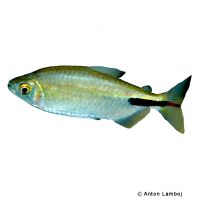Long-fin Tetra (Brycinus longipinnis)
| Long-fin Tetra Brycinus longipinnis | |
|---|---|
| Name | Long-fin Tetra |
| Name Lat. | Brycinus longipinnis |
| Synonym | Alestes longipinnis |
| Family | African Tetras |
| Family lat. | Alestidae |
| Order | Characins |
| Order lat. | Characiformes |
| Origin | Western Africa |
| Habitat | Rivers, streams |
| Diet | Omnivore |
| pH | 6.0-7.5 |
| Behavior | Peaceful |
| Keeping | Group |
| Care Level | Moderate |
| Reproduction | Egg scatterer |
| Breeding | Difficult |
| Life Span | 3-5 years |
| Protection | No |
| Metric Units | |
| Size | 13 cm |
| Temperature | 22-25 °C |
| Hardness | 5-15 °dH |
| Aquarium | 100 cm / 200 l |
| US Units | |
| Size | 5" |
| Temperature | 72-77 °F |
| Hardness | 89-267 ppm |
| Aquarium | 50 gal |
Distribution and habitat
The distribution areas of the longfin tetra are rivers and lakes on the Atlantic coast from Gambia to Congo. There they live mainly in the upper and lower reaches of large rivers. However, they are occasionally found in small rivers and streams as well as in the estuaries of rivers in brackish and salt water.
Maintenance
They prefer aquariums with plenty of swimming space. In not too bright (floating plant cover), well planted aquariums with dark substrate they show the most beautiful coloration.
No ammonia, ammonium and nitrite should be detectable, the nitrate value should not exceed 100 mg/l. To ensure the water quality and oxygen content, a filter and heater adapted to the aquarium size is required, as well as lighting for the species-appropriate day-night rhythm of the animals.
Diet
They require mainly animal food, supplemented with vegetable. The food supply consists of live food, such as daphnia, cyclops tubifex, mysis and black mosquito larvae, which are also eaten in frozen form without any problems, plus commercially available frozen special food mixtures, supplemented with high-quality dry food (flakes, granules), which is well accepted. Washed lettuce and dry food with high vegetable content (e.g. spirulina, kelp) should be offered to cover their need for vegetable food. Especially mysis and black mosquito larvae should not be missing, as they are needed to maintain luminosity and body color.
Regular and varied feeding promotes health and prevents deficiency symptoms. Only as much should be fed as is eaten immediately (in a maximum of 10 minutes).
Behaviour and compatibility
They are peaceful, unproblematic schooling fish for the community tank. At least 5, but preferably more longfin tetras should be kept together.
Generally, only compatible fish species with similar requirements for water quality and water temperature should be kept together.
Sex dimorphism
In males, the rays of the dorsal fin are greatly elongated.
Reproduction and breeding
They spawn in the open water at the bottom. The larvae hatch after about 35 hours and swim freely after 7 days. Young fish must be fed several times a day with special rearing food.
In a community tank breeding is hardly possible, because the spawn is easy prey here.
Important
Experience shows that the life expectancy of longfin tetras is reduced if the water temperature exceeds 25 °C for a prolonged period
The well-being of the fish should be checked regularly. Temperature should be checked daily, pH, hardness and nitrate levels at least fortnightly. Regular partial water changes are recommended, even if the pollutant load has not yet reached the upper limit. Sudden changes in water quality should be avoided. Newly introduced fish must be accustomed slowly to the water in the aquarium.
Further literature can be found in your pet store.
References
Text: petdata; Image: Anton Lamboj
Source: BMELV (1998): Tierschutzgutachten - Haltung von Zierfischen (Süßwasser); RIEHL & BAENSCH (2006): Aquarien Atlas Bd. 1, Mergus Verlag; ENGELMANN (2005): Zootierhaltung - Tiere in menschlicher Obhut: Fische, Verlag Harri Deutsch
- Gemäß § 21 Abs. 5 Tierschutzgesetz idgF
